
 Nuclear Attack Submarine 1958-1985.
Nuclear Attack Submarine 1958-1985.Cold War US Subs
GUPPY | Barracuda class | Tang class | USS Darter | T1 class | X1 class | USS Albacore | Barbel classUSS Nautilus | USS Seawolf | Migraine class | Sailfish class | Triton class | Skate class | USS Tullibee | Skipjack class | Permit class | Sturgeon class | Los Angeles class | Seawolf class | Virginia class
Fleet Snorkel SSGs | Grayback class | USS Halibut | Georges Washington class | Ethan Allen class | Lafayette class | James Madison class | Benjamin Franklin class | Ohio class | Colombia class
USS Seawolf (SSN-575) was the third of this name, and the USN second nuclear submarine, and a very interesting as she was the only one ever fitted with a Sodium liquid metal cooled beryllium-moderated nuclear reactor S2G. This was supposed to be the next gen “super-safe” reactor, but it was not to succeed. Her overall design called SCB 64A was a variant of Nautilus, but with many changes, including a new massive BQR-4 passive sonar giving her bow shape. After she received standard pressurized water reactor by 30 September 1960 she stayed in service until 1987 as one of the proud grandfather of the US nuclear fleet. #coldwar #usn #USNavy #unitedstatesnavy #submarine #nuclearattacksubmarine #ussseawolf
The second SSN
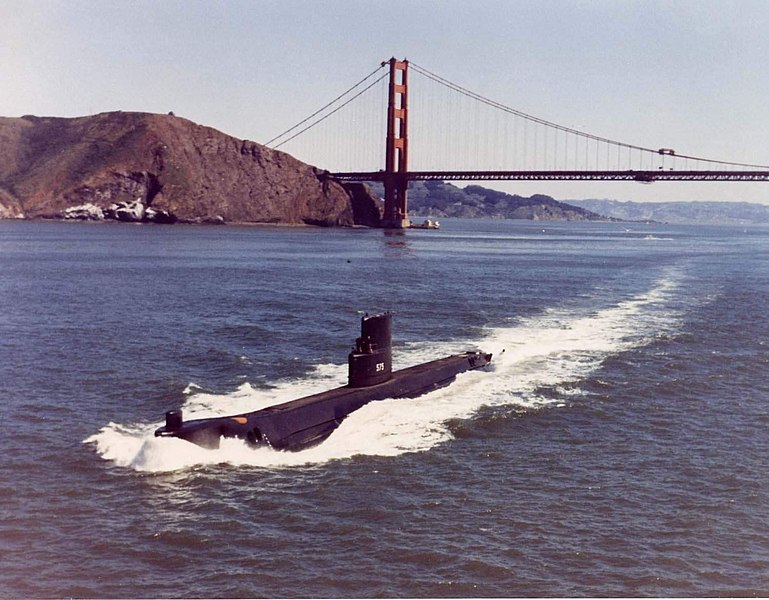
The early days of nuclear propulsion were exciting ones. Nothing was perfectly fixed it was more in the realm of experimentation since 1943 than an industrial reality yet. Thus, scientists had different ideas on how to implement fusion and cooling, and what solution to use for the best effect. The watercooled reactor has a massive problem (still acute today as Chernobyl and Fukushima showed): Once the coolant is no longer distributed due to energy drop or malfunction, the control bars starts to overheat and the reactor is ultimately condemned to explode. There is no “no-energy” solution to keep it under control. Using a solution where without energy the reactor would simply shut down naturally without consequences is much more appealing, both for civilian and expecially more for military applications, as for example a singlz depht charge blast could damage watercooling pipes or just shut down generators. WW2 showed how many times ships became sitting ducks after a powerful failure.
A short lived sodium-cooled reactor SSN
Thus, was designed the Submarine Intermediate Reactor (SIR) nuclear plant by General Electric at its Knolls Atomic Power Laboratory in the 1950s as an alternative. It wasprototyped in West Milton, New York and eventually designated “S1G”. When all tests were made and the reactor certified, it was adapted to submarine installation, and became the next SSN plan under the name of “S2G”.
This was a sodium-cooled reactor:
“Although makeshift repairs permitted the Seawolf to complete her initial sea trials on reduced power in February 1957, Rickover had already decided to abandon the sodium-cooled reactor. Early in November 1956, he informed the Commission that he would take steps toward replacing the reactor in Seawolf with a water-cooled plant similar to that in the Nautilus. The leaks in the Seawolf steam plant were an important factor in the decision but even more persuasive were the inherent limitations in sodium-cooled systems. In Rickover’s words they were “expensive to build, complex to operate, susceptible to prolonged shutdown as a result of even minor malfunctions, and difficult and time-consuming to repair”.
-Atomic Energy Commission’s Historian
Indeed this new reactor was a one-off experiment. It was just too complex to be installed aboard a submarine and dismissed by Hyman G. Rickover -The father of USN subs- himself.
It was in fact replaced after sufficient operations with the same S2Wa carried by USS Nautilus when drydocked on 12 December 1958. What was left was an advanced sonar and other innovative systems.
Other innovations
The Seawolf, SSN-575 however shared the same basic “double hull” twin-screw (dimensions diverged a bit). It was fully armed and operational but like USS Nautilus stayed largely an experimental vessel, presented however like a new generation of “hunter-killer submarine”, but she was in reality a single test platform for the S2G LMFR reactor and test new sonars. It had another refit and role change again to prolongate her active life now she was obsolete (no teardrop hull, many systems now superseded) and was refitted in 1971 – 1973 with a new light water system and noise reduction measures to be used for covert operations in foreign waters. All her long active life was that of a testbed submarine, more than an operational boat, albeit she took part in some fleet exercises.
Construction
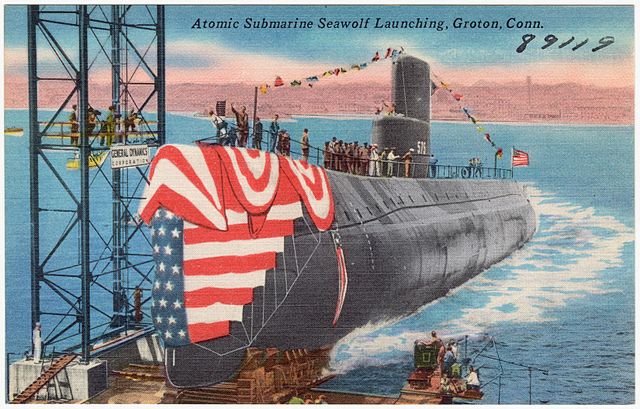
Launch Ceremony. Mrs. W. Sterling Cole, wife of congressman from New York, when christening the Seawolf failed to break the bottle and it slipped out of her hand. Old salts saw it as a bad start, but despite her three reconstructions and many dangerous operations later in her life putting the crew to high stress, she always came back home.
Both Nautilus and Seawolf were part of the FY52 programme. USS Seawolf’s keel was laid down 7 September 1953 at Electric Boat, General Dynamics, Groton, Connecticut, one year after Nautilus (laid down 14 June 1952). She was launched on 21 July 1955, sponsored by Mary Elizabeth (Thomas) Cole, wife of New York Congressman W. Sterling Cole, as the boat’s name did not referred anyone. She was commissioned on 30 March 1957, two years after Nautilus, but still under supervision of general manager Bill Jones. He had his officers modified to house different teams in the same space, Rickover’s, Navy observers, but also the Atomic Energy Commission and its independent labs. Given the complexity of both Nautilus and this new project, teamwork was required.
The Power Plant Project manager Dennis B. Boykin III however led his own division concerning the power plant installation and was back in the same yard for the reactor conversion, succeeded by Gardner Brown. Lieutenant James Earl “Jimmy” Carter for the anecdote was to be his Engineering Officer but resigned his commission after learning the death of his father in 1953.
Design of the class
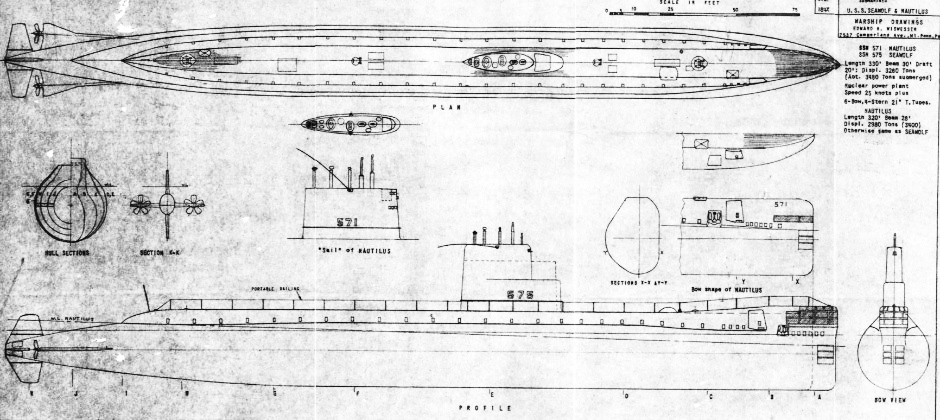
general schematics, reconstituted. Seems the originals were not declassified yet. Note also the Nautilus kiosk to compare.
Hull and general design
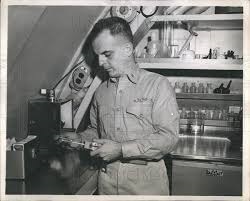 USS Seawolf, a name very much intended to underline its “hunter killer” role, less experimental/grounbreaking than “Nautilus”, was a clear sign sent to USSR by Eisenhower. But she still reproduced the hull of Nautilus to gain time, changing only details. The new submarine was however different in mensurations and tonnage. At 3,260 tons surfaced (vs. 3,530t) she was lighter but had more internal capacity and ended at 4,150 tons submerged (vs. 4,092t). She was ended longer than nautilus at 337 ft (103 m) and even longer at 387 ft (118 m) post conversion. She became the largest submarine ever built anywhere, although still a bit shy of the WW2 IJN STO class. Her Beam was of 28 ft (8.5 m) and Draft of 23 ft (7.0 m) versus 26 ft (7.9 m) in draft for Nautilus, but the beam was identical and both had the same hull design overall, jusy stretched on Seawolf for the new, more complex reactor.
USS Seawolf, a name very much intended to underline its “hunter killer” role, less experimental/grounbreaking than “Nautilus”, was a clear sign sent to USSR by Eisenhower. But she still reproduced the hull of Nautilus to gain time, changing only details. The new submarine was however different in mensurations and tonnage. At 3,260 tons surfaced (vs. 3,530t) she was lighter but had more internal capacity and ended at 4,150 tons submerged (vs. 4,092t). She was ended longer than nautilus at 337 ft (103 m) and even longer at 387 ft (118 m) post conversion. She became the largest submarine ever built anywhere, although still a bit shy of the WW2 IJN STO class. Her Beam was of 28 ft (8.5 m) and Draft of 23 ft (7.0 m) versus 26 ft (7.9 m) in draft for Nautilus, but the beam was identical and both had the same hull design overall, jusy stretched on Seawolf for the new, more complex reactor.
USS Seawolf carried a crew of 101 officers and men, about the same as for Nautilus (105: 13 officers, 92 enlisted). They shared accomodations which repeated Nautilus internal arrangement, also to gain time in design. There was no experience return when her construction started.
Her other big difference with Nautilus was a more advanced, stepped conning tower, the best in design at the time, experimented on the GUPPY. The staff gathered not in the upper, but lower part in the step, protected by a large plexiglas bubble, retractable entirely to avoid drag, and bridge access trunk in the fin.
Powerplant
 Left: comparatives of the the seawolf prior and after reconstruction of spec ops, on HI sutton. As said above, the initial Westinghouse SIR Mk II reactor (Navy denomination S2G) was tested for a short time, proved too complex for military applications and thus during a refit (see later) replaced by the simpler S2Wa in 1960. This however needed to streched the hull to install it; It was powering geared steam turbines of the same type as Nautilus, driving two shafts with the same propellers agains, and for a total output of c15,000 shp (11,000 kW). This procured a top speed of 23 knots (43 km/h) surfaced, 19 knots (35 km/h) submerged. Figures before the conversion are still top secret. This was the same as Nautilus.
Left: comparatives of the the seawolf prior and after reconstruction of spec ops, on HI sutton. As said above, the initial Westinghouse SIR Mk II reactor (Navy denomination S2G) was tested for a short time, proved too complex for military applications and thus during a refit (see later) replaced by the simpler S2Wa in 1960. This however needed to streched the hull to install it; It was powering geared steam turbines of the same type as Nautilus, driving two shafts with the same propellers agains, and for a total output of c15,000 shp (11,000 kW). This procured a top speed of 23 knots (43 km/h) surfaced, 19 knots (35 km/h) submerged. Figures before the conversion are still top secret. This was the same as Nautilus.
Later she also tested bow thrusters above her pressure hull (two forward and two aft) for precise manoeuvering, after her “spec ops” last overhaul of the late 1970s. During the same she was fitted with a DSRV for deep sea exploration, infiltration or rescue (see career for more details).
Torpedo Tubes
Despite her enormous size, USS Seawolf, like Nautilus, was armed the same, with six 21-inch (533 mm) torpedo tubes forward, behind sliding doors and with pneumatic systems to reduce noise.
These were Mark 50 torpedo tubes close together in the straight section of the bow, launching the trusted 21″ (53.3 cm) Mark 35 type (design 1946, service 1949) weighting 1,770 lbs. (803 kg) 13 ft 5 in (4.089 m) with a 270 lbs. (122.5 kg) HBX warhead, range 15,000 yards (13,710 m) at 27 knots. It used active and passive acoustic, spiral search. These tubes had two reloads each for 22 in all.
After her next refit in 1958-60 (new reactor) she was likely given updated torpedoes Mark 39 (1956) 1,275 lbs. (578 kg), 11 ft 1 in (3.378 m) long with 130 lbs. (59 kg) HBX warhead, 13,000 yards (11,890 m) range at 15.5 knots and Wire-guidance/passive acoustic sonar, far more accurate.
Sensors
She started her career with a brand new, innovative sonars:
BQS-4 bow sonar
An active/passive detection sonar comprising the AN/BQR-2 passive detection system and active detection capability plus BQS-4 active component (7 vertically stacked cylindrical transducers in the chin bow dome) to transmit active “pings.” It can operate in either automatic echo-ranging or old school “ping mode” if required.
BQR-4A sonars
Long range array sonar suite also used on the GUPPY class boats. Older model kept for redundancy.
BPS-12 radar
Medium-range surface search and navigation radar, modified BPS-5 raised by a periscope antenna.
BLR-1 ECM suite
Radar frequency tuner unit 90 MHz to 180 MHz, for AN/BLR-1 or AN/SLR-2 electronic counter measures receiver, British, adopted by the USN and soon obsolete.
In the 1960s her BPS-12 radar and BLR-1 ECM suite were replaced by a BPS-15 radar and WLR-1 ECM suite. In 1969 she lost her main BQS-4 bow sonar for a SQS-51 sonar while provision was made for a DSRV, and four side-thrusters added.
profile
⚙ specifications as completed 1957 |
|
| Displacement | 3,260 tons surfaced, 4,150 tons submerged |
| Dimensions | 337 x 28 x 23ft (103 x 8.5 x 7.0 m) |
| Propulsion | 2 shafts geared steam turbines, S2G reactor, 15,000 shp (11,000 kW) |
| Speed | 23 kts surfaced, 19 ks submerged |
| Range | Unlimited (c30 days operations without supply) |
| Armament | 6 × 21-inch (533 mm) torpedo tubes |
| Sensors | BPS-12 radar, BQS-4, BQR-4A sonars, BLR-1 ECM suite |
| Crew | 101 officers and men |
Career of USS Seawolf
USS Seawolf departed New London in Connecticut, on 2 April, making her shakedown cruise off Bermuda and back on 8 May. 16 May-5 August saw her travelling to Key West for her first fleet training exercises. On 3 September she crossed the North Atlantic for NATO exercises with other fleets, and was back to Newport, making a go and back underwater run all the way coast to coast, 6,331 nonstop. On the 4th, President Dwight D. Eisenhower was aboard for a short presentation cruise.
Atlantic and Mediterranean Operations
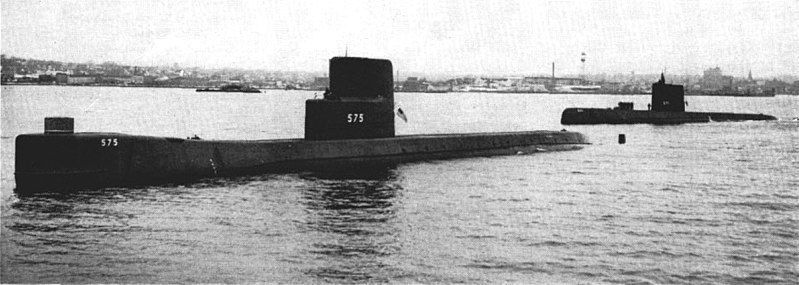
USS Nautilus and Seawolf in 1957
By November she sortied in the Caribbean for an exercise in November and next month entered her first restricted availability until 6 February 1958. She trained along east coast until early August and started another underwater cruise from 7 August to 6 October, over 13,700 nautical miles (25,400 km), an impressive feat earning her a Navy Unit Commendation. This time was indeed superior to the usual patrol time of any GUPPY class.
USS Seawolf however reported many issues with her reactor: It was too difficult to maintain, having unreliable superheaters which were rarely operational and construction of rolled steel vs forged steel were the main reason behind the way these superheaters were unable to provide a full capacity inside a submarine. The general conclusion was that it was unsuitable for use on a military submarine, better for a land plant and other applications. Thus, she entered Electric Boat’s drydock in Groton, by 12 December 1958 for a complete change of powerplant exhanging it for a S2Wa PWR. This conversion ended by 30 September 1960.
On 18 April 1959, the radioactive S2G plant was sealed into a 30-foot high stainless steel containment vessel, towed, then sunk 120 miles off the eastern coast of Maryland under a known 9,100 feet fault. The Navy was later unable to relocate the container but guaranteed the deterioration of the container was estimated longer than the radioactive material decay.
Back to operation, USS Seawolf made a three-week refrseher cruiser, qualifications, and by 25 October, November and December retirned to fleet exercises. By 9 January 1961, she was posted to San Juan for local operations and on the 25th was detached to look for the disappeared Portuguese passenger liner Santa Maria after her SOS, seized by pirates. She made contact off the coast of Brazil on 1 February, the ship latter surrendering in Recife. After training back on the east coast she started a two-month oceanographic voyage to Portsmouth in England and back to New London on 19 September 1961.
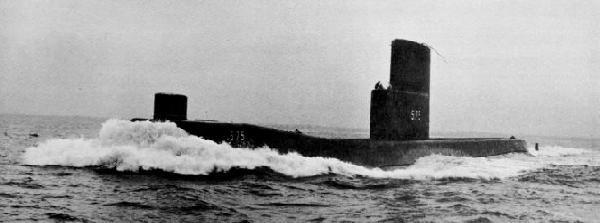
In 1963 she searched after the lost USS Thresher (SSN-593) and returned to fleet operations until April 1964. On 28 April she sailed to New London and the Gibraltar, the gate of the Mediterranean for a three month plus deployment with the Sixth Fleet. She screened and trained with USS Enterprise (CVAN-65) battle group alongside USS Long beach (CGN-9), and the also nuclear-powered USS Bainbridge (DLGN-25) to showcased the world’s first all nuclear task force. Beack to East Coast exercises until 5 May 1965 she had an overhaul at Portsmouth Naval Shipyard and standardized to SUBSAFE, a work going on until September 1966.
USS Seawolf left Portsmouth on 24 August 1967 for New London in Connecticut as new home port, made a refresher training in the Caribbean, weapons/sensors fill qualifications. She stopped at Charleston for a change of propellers and followed by sea trials. In 1967 she was back to home port and ventured off the coast of Maine in early January 1968 but was grounded, damaging her stern so she was repaired in New London and was back in operations on 20 March 1969, tested in the Caribbean Sea in June-July, then returned with the Sixth Fleet from 29 September to 21 December 1969.
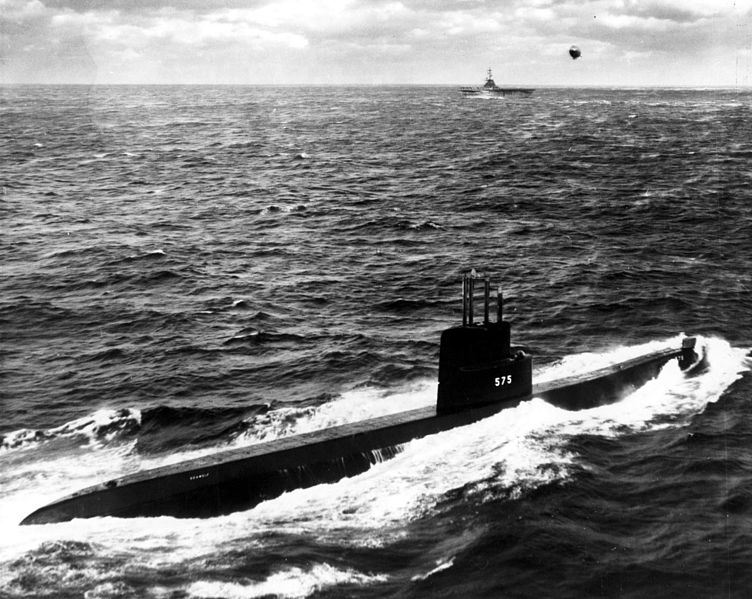
Sailing with USS Essex
Pacific Operations as “spy sub”
Back to the East Coast by November 1970 she was homeported in the pacific, to Vallejo, California via the Panama Canal on the 17th and reporting to the Pacific Fleet. There, she was planned as a “spy submarine”, shadowing Soviet submarines and retrieving test weapons from the seabed or tapping communications cables.
For this, she needed an extensive overhaul, which started at Mare Island Naval Shipyard from 8 January 1971 to 21 June 1973:
She became in essence a ‘special project platform’ with a 52-foot hull extension, forward of the sail to house intelligence gathering equipment, an “aquarium” housing a VDS and retrieval equipment, jet thrusters fore and aft, saturation diver lockout, new gondola underneath the hull, retractable “skegs” for bottom station and move.
She was tested off Bangor, Washington state, and returned to Mare Island on 4 September 1973 for post-fixes. In 1974 post-conversion testing/evaluation was declared over, so she started her first Pacific Fleet deployment over three months, being awarded a second Navy Unit Commendation (detailed records still classified). In 1975 she was supervised by Submarine Development Group One for more covert opeartions, eanring a Battle Efficiency “E” for 1974-75.

In 1976 she won both a second Battle “E” and Engineering “E” for her second Pacific Fleet deployment for independent operations over three months, a 89 consecutive days underwater, setting another U.S. Navy record and 3rd third Navy Unit Commendation.
In 1977 she won a 3rd Battle “E” 2nd engineering “E” and for her third Pacific Fleet deployment with 79 consecutive days, earned a 4th Navy Unit Commendation and Navy Expeditionary Medal. In 1978, she started her fourth Pacific Fleet deployment followed by a well deserved overhaul. Many incidents were indeed reported with the reactor and oxygen systems. By February 1980 she had a turbine generator failing during sea trials and she was drydocked again.

Reconstitution of SSN-575 in Operation Ivy Bells, by Hi Sutton with gunnarson
In August 1981 she made her 5th Pacific deployment but systems were keep failing just out of obsolescence putting the crew’s morale close to breaking. During a mission however, USS seawolf managed to tap a submarine communications cable in the Sea of Okhotsk, but was trapped by an extreme storm shaking her enough for her skegs to dig deep into the seabed causing her reactor heat exchanger to be clogged with sand. The captain eventually decided to jettison her underbelly gondola and she lost silence, being detected by a Soviet fishing trawler. She however exited the area at full speed and arrived in international waters. No doubt the Kremlin took notice.
Back home by October 1981 she still received the Navy Expeditionary Medal for her efforts, but badly needed another overhaul.
Still in high demand though, this was cosmetic and by 1983 she condicted her sixth Pacific deployment over 76 days and back to Mare Island by May this year, being awarded a Navy Expeditionary Medal, Battle “E,” Engineering “E,” Supply “E,” Damage Control “DC” awards. In 1984, she out-done herself by a 93-day deployment, this time to the Western Pacific and was awarded her third Supply “E,” first Communications “C” Deck Seamanship Award which at least alleviate the high crew’s stress.
In April 1986, she departed for her last Western Pacific deployment, short, and was back to Mare Island by June and a decommissioning on 30 March 1987, after which she was stricken on 10 July and mothballed. After which she entered the Navy’s nuclear Recycling Program on 1 October 1996, completed by 30 September 1997.
Read More/Src
Books
Conway’s all the world’s fighting ships.
Breeder Reactor Programs: History and Status. International Panel on Fissile Materials.
Friedman (1994), p. 109. “Attempt to christen the Seawolf (SSN-575)”. NavSource Online: Submarine Photo Archive.
Pearson, Richard (16 March 1987). “Ex-Congressman W.S. Cole, Atomic Energy Expert, Dies”. Washington Post.
“James Earl Carter, Jr”. Naval History and Heritage Command. 19 October 1997.
Sontag, Sherry; Drew, Christopher; Drew, Annette Lawrence. Blind Man’s Bluff: The Untold Story of American Submarine Espionage.
The Boston Globe, 17 May 1980
Links
seawolf-ssn575.com – vets site
on militaryperiscope.com
on fissilematerials.org
On HI Sutton
on enseccoe.org/
on hazegray.org/
on navsource.org/
on navypedia.org/
web.archive.org/ submarinehistory.com/PresidentCarter.html
on wikipedia.org/
Accident on SSN 757
commons.wikimedia.org/ on USS_Seawolf_(SSN-575)
facebook.com group

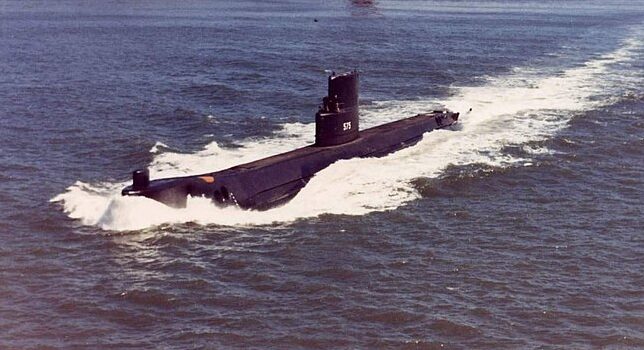
 Latest Facebook Entry -
Latest Facebook Entry -  X(Tweeter) Naval Encyclopedia's deck archive
X(Tweeter) Naval Encyclopedia's deck archive Instagram (@navalencyc)
Instagram (@navalencyc)





 French Navy
French Navy Royal Navy
Royal Navy Russian Navy
Russian Navy Armada Espanola
Armada Espanola Austrian Navy
Austrian Navy K.u.K. Kriegsmarine
K.u.K. Kriegsmarine Dansk Marine
Dansk Marine Nautiko Hellenon
Nautiko Hellenon Koninklije Marine 1870
Koninklije Marine 1870 Marinha do Brasil
Marinha do Brasil Osmanlı Donanması
Osmanlı Donanması Marina Do Peru
Marina Do Peru Marinha do Portugal
Marinha do Portugal Regia Marina 1870
Regia Marina 1870 Nihhon Kaigun 1870
Nihhon Kaigun 1870 Preußische Marine 1870
Preußische Marine 1870 Russkiy Flot 1870
Russkiy Flot 1870 Svenska marinen
Svenska marinen Søværnet
Søværnet Union Navy
Union Navy Confederate Navy
Confederate Navy Armada de Argentina
Armada de Argentina Imperial Chinese Navy
Imperial Chinese Navy Marinha do Portugal
Marinha do Portugal Mexico
Mexico Kaiserliche Marine
Kaiserliche Marine 1898 US Navy
1898 US Navy Sovietskiy Flot
Sovietskiy Flot Royal Canadian Navy
Royal Canadian Navy Royal Australian Navy
Royal Australian Navy RNZN Fleet
RNZN Fleet Chinese Navy 1937
Chinese Navy 1937 Kriegsmarine
Kriegsmarine Chilean Navy
Chilean Navy Danish Navy
Danish Navy Finnish Navy
Finnish Navy Hellenic Navy
Hellenic Navy Polish Navy
Polish Navy Romanian Navy
Romanian Navy Turkish Navy
Turkish Navy Royal Yugoslav Navy
Royal Yugoslav Navy Royal Thai Navy
Royal Thai Navy Minor Navies
Minor Navies Albania
Albania Austria
Austria Belgium
Belgium Columbia
Columbia Costa Rica
Costa Rica Cuba
Cuba Czechoslovakia
Czechoslovakia Dominican Republic
Dominican Republic Haiti
Haiti Hungary
Hungary Honduras
Honduras Estonia
Estonia Iceland
Iceland Eire
Eire Equador
Equador Iran
Iran Iraq
Iraq Latvia
Latvia Liberia
Liberia Lithuania
Lithuania Mandchukuo
Mandchukuo Morocco
Morocco Nicaragua
Nicaragua Persia
Persia San Salvador
San Salvador Sarawak
Sarawak Uruguay
Uruguay Venezuela
Venezuela Zanzibar
Zanzibar Warsaw Pact Navies
Warsaw Pact Navies Bulgaria
Bulgaria Hungary
Hungary

 Bundesmarine
Bundesmarine Dutch Navy
Dutch Navy Hellenic Navy
Hellenic Navy Marina Militare
Marina Militare Yugoslav Navy
Yugoslav Navy Chinese Navy
Chinese Navy Indian Navy
Indian Navy Indonesian Navy
Indonesian Navy JMSDF
JMSDF North Korean Navy
North Korean Navy Pakistani Navy
Pakistani Navy Philippines Navy
Philippines Navy ROKN
ROKN Rep. of Singapore Navy
Rep. of Singapore Navy Taiwanese Navy
Taiwanese Navy IDF Navy
IDF Navy Saudi Navy
Saudi Navy Royal New Zealand Navy
Royal New Zealand Navy Egyptian Navy
Egyptian Navy South African Navy
South African Navy






























 Ukrainian Navy
Ukrainian Navy dbodesign
dbodesign